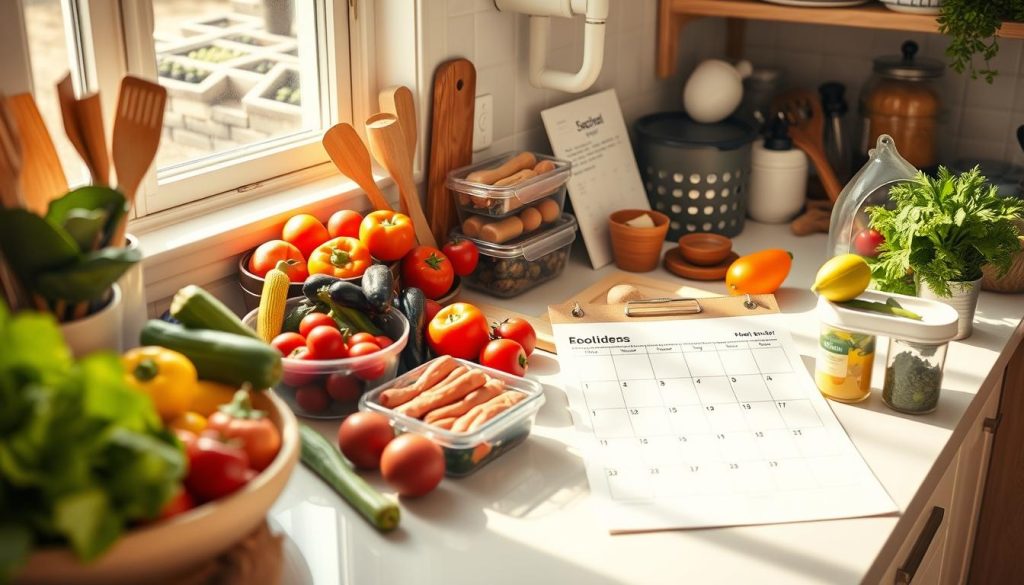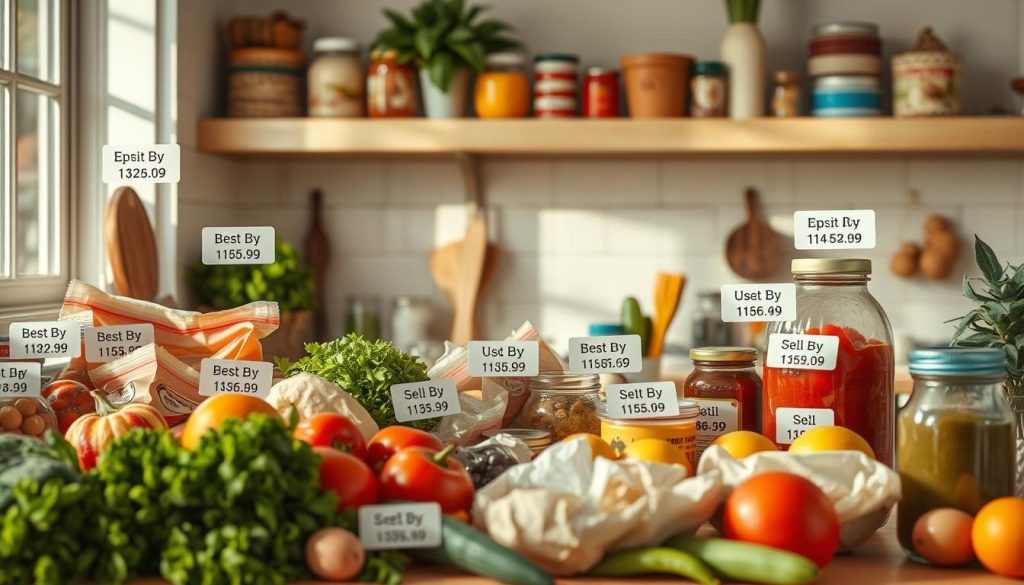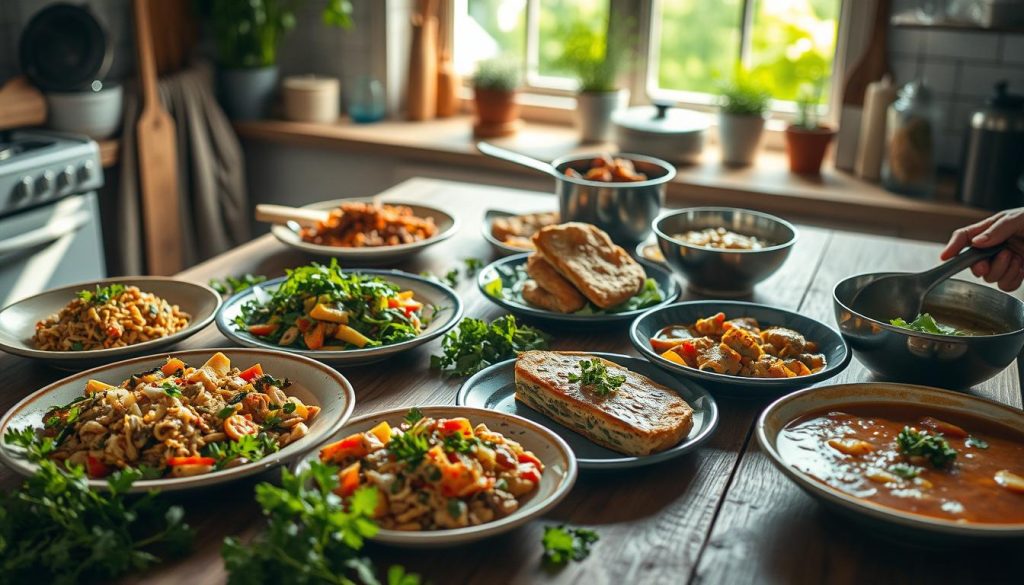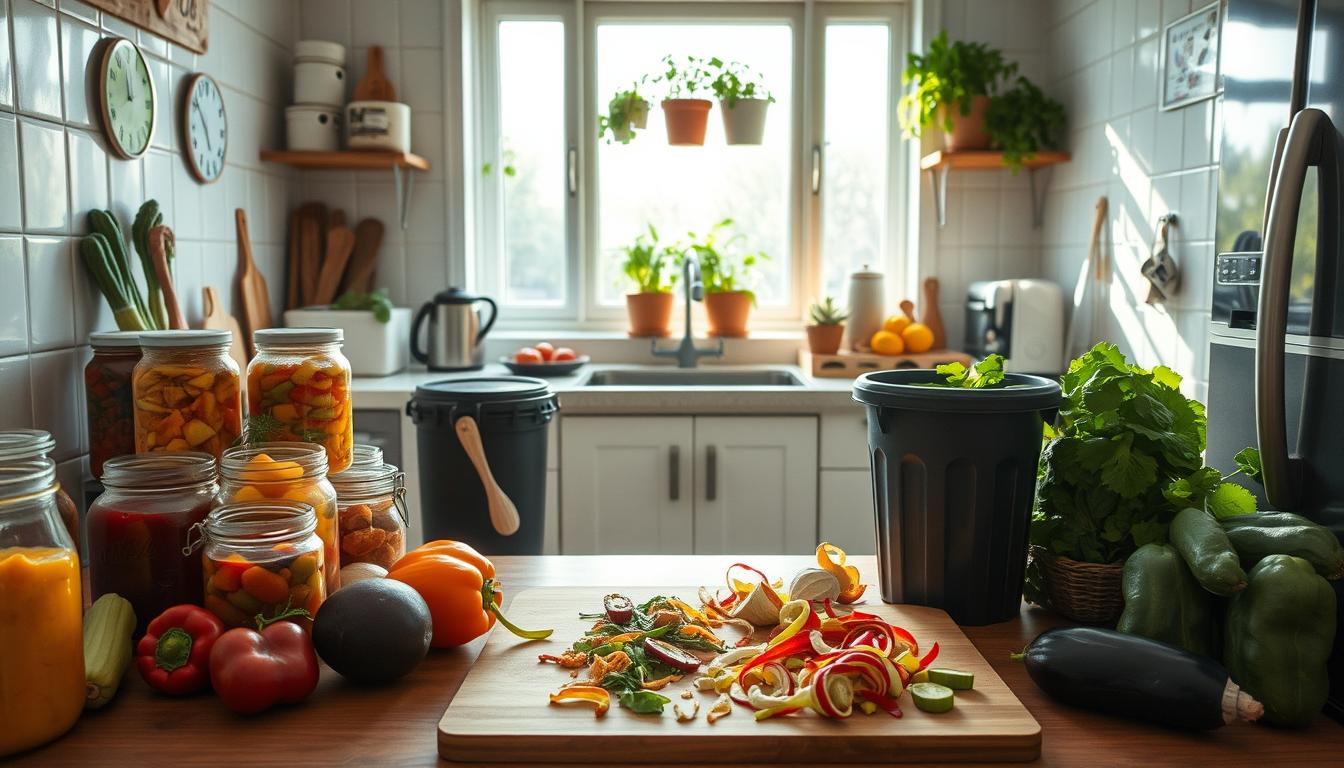I’m on a mission to create a sustainable kitchen, and I want you to join me. Food waste reduction is key to a zero waste lifestyle. Did you know the average American family throws away 25% of their food? That’s like tossing one in every four grocery bags!
Creating a sustainable kitchen is crucial for reducing our environmental impact. We can do this through smart meal planning and creative cooking. There are many ways to cut down on waste and use our resources better.
In this article, I’ll share practical tips for your sustainable kitchen. We’ll look at how small changes can make a big difference for our planet and our wallets. Let’s start making a difference, one meal at a time!
Understanding the Impact of Food Waste on Our Planet
I’ve been looking into the effects of food waste, and it’s eye-opening. Food waste is a bigger problem than many realize. It impacts our environment, economy, and society in significant ways.
Environmental Consequences of Food Waste
The environmental impact of food waste is staggering. When we toss food, we’re not just wasting the food itself. We’re wasting all the resources used to produce it – water, land, and energy. This waste contributes to greenhouse gas emissions and climate change.
Economic Implications of Wasted Food
The economic implications of food waste are equally concerning. In the U.S., we’re throwing away billions of dollars worth of food each year. This affects household budgets and business profits alike. It’s like tossing money straight into the trash.
Social Impact of Food Waste in a World with Hunger
The social impact of food waste is perhaps the most heartbreaking. While millions struggle with hunger, we’re discarding perfectly good food. This disparity highlights a pressing need for better food distribution and waste reduction strategies.
| Impact Area | Key Facts |
|---|---|
| Environmental | 8% of global greenhouse gases come from food waste |
| Economic | U.S. households waste $1,600 per year on uneaten food |
| Social | 1 in 9 people globally are undernourished |
By understanding these impacts, we can take steps to reduce our food waste. This will help create a more sustainable future. Every small action counts in this collective effort to minimize waste and maximize resources.
Smart Meal Planning: The First Step to Reducing Waste

Meal planning is crucial for reducing food waste in my kitchen. By planning my meals each week, I avoid impulse buys and save on groceries. Here’s how I make meal planning work:
First, I check what’s in my fridge and pantry. This stops me from buying things I already have. It also helps me use up food before it goes bad. Then, I make a weekly menu, thinking about how much to cook.
When I go shopping, I only buy what’s on my list. This has really cut down my food waste. I also plan to use leftovers in future meals or freeze them for later.
| Meal Planning Benefits | Impact on Food Waste |
|---|---|
| Reduced impulse buying | Less unused food |
| Precise portion control | Fewer leftovers |
| Strategic grocery shopping | Decreased spoilage |
| Planned leftover usage | Minimal discarded food |
By using these meal planning tips, I’ve seen a big drop in food waste at home. It’s a simple but powerful way to make my kitchen more sustainable.
Mastering the Art of Food Storage for Longevity
Learning how to store food properly can save you money and reduce waste. Let’s look at some ways to keep food fresh for longer.
Proper refrigeration techniques
It’s important to keep your fridge at the right temperature. I set mine to 40°F (4°C) or below to slow down bacteria. Raw meats go on the bottom shelf to avoid drips.
Fruits and veggies have their own drawers. Eggs last longer in their carton on an inside shelf.
Freezing foods effectively
Freezing is a great way to keep food fresh longer. I remove air from freezer bags to stop freezer burn. Before freezing fruits and veggies, I blanch them to keep their color and nutrients.
Labeling items with dates helps me know how fresh they are.
Pantry organization for extended shelf life
A tidy pantry helps prevent food from going bad. I use the “first in, first out” rule, so newer items are behind older ones. Airtight containers keep dry goods fresh and pest-free.
Here’s a quick guide to the best storage temperatures for common pantry items:
| Food Item | Optimal Temperature | Storage Duration |
|---|---|---|
| Rice | 70°F (21°C) | Up to 2 years |
| Flour | 60-70°F (15-21°C) | 6-8 months |
| Canned goods | 50-70°F (10-21°C) | 1-5 years |
| Oils | 60-70°F (15-21°C) | 6-12 months |
By using these food storage tips, I’ve cut down on waste in my kitchen. It’s surprising how much of a difference small changes in how we store food can make!
Decoding Expiration Dates: What You Need to Know

I’ve often found myself staring at food labels, wondering if it’s safe to eat something past its printed date. Let’s unravel the mystery of expiration dates and boost our food safety knowledge.
Food labels can be confusing. We see terms like “best-by,” “use-by,” and “sell-by” dates. But what do they really mean? “Best-by” dates aren’t about safety. They tell us when food is at its peak quality. “Use-by” dates are more strict. They indicate when perishable foods might become unsafe to eat.
To reduce food waste and maintain food safety, I’ve learned to trust my senses. If food looks and smells fine, it’s often safe to eat even past its best-by date. But I’m always cautious with items like meat and dairy.
| Label Type | Meaning | Action |
|---|---|---|
| Best-by | Peak quality date | Use senses to check |
| Use-by | Safety concern date | Consume or freeze by this date |
| Sell-by | Store inventory date | Safe to eat after this date |
Remember, proper storage is key to extending food life. I keep my fridge at the right temperature and organize it well. This helps me use food before it spoils and reduces waste. By understanding these dates, we can make smarter choices about our food, save money, and help the environment.
Creative Cooking: Turning Leftovers into Delicious Meals

Turning leftovers into new dishes is a smart way to reduce waste. I enjoy making creative use of leftover recipes and scraps. It’s like a fun cooking journey!
Repurposing Leftover Ingredients
Got extra veggies? Add them to a frittata or stir-fry. Use day-old bread for croutons or breadcrumbs. Shred leftover roast chicken for tacos or salads. The options are endless.
Recipes Using Common Kitchen Scraps
Don’t throw away veggie tops and peels! Carrot greens make a tasty pesto. Broccoli stems are great for slaw. Potato peels can be baked into crispy chips. Even apple cores can make homemade vinegar.
Batch Cooking and Meal Prep Strategies
Batch cooking and meal prep really help reduce waste. I spend a few hours on Sundays prepping and cooking big batches. Then, I portion them out for easy meals all week. It saves time and reduces takeout.
| Batch Cooking Item | Meal Ideas |
|---|---|
| Roasted Vegetables | Grain bowls, omelets, pasta dishes |
| Shredded Chicken | Sandwiches, salads, enchiladas |
| Cooked Quinoa | Breakfast porridge, veggie burgers, stuffed peppers |
With these tips, you’ll waste less food and enjoy tasty meals all week. It’s good for your wallet and the planet!
Composting: Turning Kitchen Scraps into Garden Gold
I’ve found a great way to cut down on food waste and help the planet. Composting turns kitchen scraps into soil that’s good for plants. It’s simple and can be done by anyone, no matter the size of your garden or balcony.
To start, I collect fruit and veg peels, coffee grounds, and eggshells in a bin. These items break down fast, making great compost. But, I skip adding meat, dairy, or oils because they attract pests and slow down the process.
If you have little space, try vermicomposting. I use a small bin with red wiggler worms to compost my waste. These worms work hard, turning scraps into dark, rich compost in weeks.
| Compostable Items | Non-Compostable Items |
|---|---|
| Fruit and vegetable scraps | Meat and fish |
| Coffee grounds and filters | Dairy products |
| Eggshells | Oils and fats |
| Tea bags | Diseased plants |
Composting cuts down on landfill waste and gives us valuable garden soil. I use my compost to make my veggie beds and potted plants healthier. It’s amazing to see my food scraps help my garden grow.
If you don’t have a garden, many community gardens accept compost. By donating, I help local food grow and support a greener community. It’s a small action that makes a big difference.
Food Waste Reduction: Strategies for a Zero Waste Kitchen
I’m excited to share my favorite strategies for creating a zero waste kitchen. Embracing a zero waste lifestyle starts with small changes in our daily habits. Let’s dive into some practical tips to make your kitchen more sustainable.
First, I always use reusable containers for storing leftovers and packing lunches. Glass jars and stainless steel containers are great alternatives to single-use plastics. Buying in bulk is another effective way to reduce packaging waste. I bring my own cloth bags or containers to the store for nuts, grains, and spices.
Food preservation techniques play a crucial role in my sustainable kitchen. Canning, pickling, and dehydrating help extend the life of fruits and vegetables. These methods not only reduce waste but also allow me to enjoy seasonal produce year-round.
Mindful consumption is key to a zero waste lifestyle. I plan my meals carefully and make a shopping list to avoid impulse purchases. When shopping, I choose loose produce over pre-packaged items and opt for products with minimal packaging.
| Strategy | Benefits | Implementation Tips |
|---|---|---|
| Use reusable containers | Reduces plastic waste | Invest in glass or stainless steel containers |
| Buy in bulk | Minimizes packaging waste | Bring your own bags or containers to stores |
| Practice food preservation | Extends food life, reduces spoilage | Learn canning, pickling, and dehydrating techniques |
| Shop mindfully | Prevents overbuying and waste | Plan meals, make lists, choose minimal packaging |
By implementing these strategies, I’ve significantly reduced waste in my kitchen. It’s a journey towards a more sustainable lifestyle, and every small step counts!
The Role of Technology in Minimizing Food Waste
Technology is making a big difference in fighting food waste. I’ve discovered some cool tools that help us all make a positive impact. Let’s see how these innovations are changing our kitchens and communities.
Food waste tracking apps
Food waste tracking apps are amazing. They let me keep an eye on what’s in my fridge and when it expires. They remind me to use up ingredients and suggest recipes. It’s like having a personal food waste manager right in my pocket!
Smart refrigerators and their impact
Smart refrigerators are changing how we store food. They track expiration dates, suggest recipes, and create shopping lists. I’m impressed by how they keep our food fresh for longer, reducing waste.
Online platforms for food sharing and donation
Online platforms connect people with extra food to those who need it. I’ve used them to donate groceries to local food salvage groups. It’s a simple way to prevent waste and help others. These platforms are building stronger, more sustainable communities, one meal at a time.
